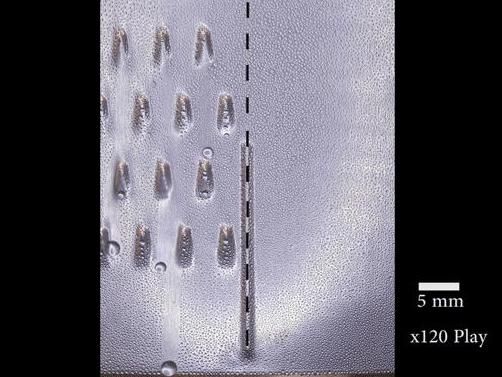Pulling water from thin air
Organisms such as cacti and desert beetles can survive in arid environments because they've evolved mechanisms to collect water from thin air. The Namib desert beetle, for example, collects water droplets on the bumps of its shell while V-shaped cactus spines guide droplets to the plant's body.

An array of slippery asymmetric bumps shows a significantly greater volume of water collected at the bottom of the surface compared to the flat slippery surfaces.
Courtesy of the Aizenberg Lab/Harvard SEAS
As the planet grows drier, researchers are looking to nature for more effective ways to pull water from air. Now, a team of researchers from the Harvard John A. Paulson School of Engineering and Applied Sciences (SEAS) and the Wyss Institute for Biologically Inspired Engineering at Harvard University have drawn inspiration from these organisms to develop a better way to promote and transport condensed water droplets.
"Everybody is excited about bioinspired materials research," said Joanna Aizenberg, the Amy Smith Berylson Professor of Materials Science at SEAS and core faculty member of the Wyss Institute. "However, so far, we tend to mimic one inspirational natural system at a time. Our research shows that a complex bio-inspired approach, in which we marry multiple biological species to come up with non-trivial designs for highly efficient materials with unprecedented properties, is a new, promising direction in biomimetics."
The new system is inspired by the bumpy shell of desert beetles, the asymmetric structure of cactus spines and slippery surfaces of pitcher plants. The material harnesses the power of these natural systems, plus Slippery Liquid-Infused Porous Surfaces technology (SLIPS) developed in Aizenberg's lab, to collect and direct the flow of condensed water droplets.
This approach is promising not only for harvesting water but also for industrial heat exchangers.
"Thermal power plants, for example, rely on condensers to quickly convert steam to liquid water," said Philseok Kim, co-author of the paper and co-founder and vice president of technology at SEAS spin-off SLIPS Technologies, Inc. "This design could help speed up that process and even allow for operation at a higher temperature, significantly improving the overall energy efficiency."
The major challenges in harvesting atmospheric water are controlling the size of the droplets, speed in which they form and the direction in which they flow.
For years, researchers focused on the hybrid chemistry of the beetle's bumps -- a hydrophilic top with hydrophobic surroundings -- to explain how the beetle attracted water. However, Aizenberg and her team took inspiration from a different possibility - that convex bumps themselves also might be able to harvest water.
"We experimentally found that the geometry of bumps alone could facilitate condensation," said Kyoo-Chul Park, a postdoctoral researcher and the first author of the paper. "By optimizing that bump shape through detailed theoretical modeling and combining it with the asymmetry of cactus spines and the nearly friction-free coatings of pitcher plants, we were able to design a material that can collect and transport a greater volume of water in a short time compared to other surfaces."
"Without one of those parameters, the whole system would not work synergistically to promote both the growth and accelerated directional transport of even small, fast condensing droplets," said Park.
"This research is an exciting first step towards developing a passive system that can efficiently collect water and guide it to a reservoir," said Kim.
Original publication
Other news from the department science

Get the chemical industry in your inbox
By submitting this form you agree that LUMITOS AG will send you the newsletter(s) selected above by email. Your data will not be passed on to third parties. Your data will be stored and processed in accordance with our data protection regulations. LUMITOS may contact you by email for the purpose of advertising or market and opinion surveys. You can revoke your consent at any time without giving reasons to LUMITOS AG, Ernst-Augustin-Str. 2, 12489 Berlin, Germany or by e-mail at revoke@lumitos.com with effect for the future. In addition, each email contains a link to unsubscribe from the corresponding newsletter.





























































